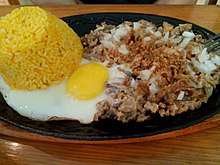Sisig
.jpg) Sizzling sisig | |
| Alternative names | Sisig |
|---|---|
| Course | Main course, snack |
| Place of origin | Philippines |
| Region or state | Pampanga |
| Created by | modern sisig, Lucia Cunanan; original sisig, no attributed creator |
| Serving temperature | Hot |
| Main ingredients | Pork jowls, ears and liver |
| 293[1] kcal | |
Sisig is a Filipino dish made from parts of pig head and liver, usually seasoned with calamansi and chili peppers.
Sisig was first mentioned in a Kapampangan dictionary in the 17th Century meaning "to snack on something sour" and "salad". It usually refers to fruits, often unripe or half-ripe, sometimes dipped in salt and vinegar. It also refers to a method of preparing fish and meat, especially pork, which is marinated in a sour liquid such as lemon juice or vinegar, then seasoned with salt, pepper and other spices.[2]
Origin
The earliest believed record of the word sisig can be traced back to 1732, and was recorded by Augustinian friar Diego Bergaño in his Vocabulary of the Kapampangan Language in Spanish and Dictionary of the Spanish Language in Kapampangan.[3] Bergaño defines sisig as a "salad, including green papaya, or green guava eaten with a dressing of salt, pepper, garlic and vinegar." There is no mention of how long this cooking style has existed prior to the coming of the Spaniards during the Age of Conquest. The introduction of meat into the dish does not have an exact date as well.

Locals believe that the addition of a pig's head and innards in the dish came from "recycling" the excess meat from the commissaries of Clark Air Base in Angeles City, Pampanga.[4] Pig heads were purchased cheap since they were not used in preparing meals for the U.S. Air Force personnel stationed there during the American Occupation of Luzon and Visayas.[5]
Sisig still has many variations with recipes varying from city to city, and sometimes, family to family, in the Kapampangan province.
Sisig queen
Lucia Cunanan of Angeles City, also known as "Aling Lucing," has been credited with reinventing sisig by using a sizzling plate to make the dish crispier.[6] The Philippine Department of Tourism has acknowledged that her "Aling Lucing's" restaurant had established Angeles City as the "Sisig Capital of the Philippines" in 1974.[7] Cunanan's trademark sisig was developed in mid-1974 when she served a concoction of boiled and chopped pig ears and cheeks seasoned with vinegar, calamansi juice, chopped onions and chicken liver and served in hot plates. Today, varieties include sisig ala pizzailo, pork combination, green mussels or tahong, mixed seafood, ostrich sisig, crocodile sisig, spicy python, frog sisig and tokwa't baboy, among others.[6]
Preparation
According to Cunanan's recipe, preparing sisig comes in three phases: boiling, broiling and finally grilling.[8] A pig's head is first boiled to remove hairs and to tenderize it. Portions of it are then chopped and grilled or broiled. Finally, coarsely chopped onions are added and served on a sizzling plate. Variations of sisig may add any of the following: eggs, ox brains, chicharon (pork cracklings), pork or chicken liver, and mayonnaise. Recently, local chefs have experimented with ingredients other than pork such as chicken, squid, tuna, and tofu.
Festival
The annual "Sisig Festival" (Sadsaran Qng Angeles) is held every year during December in Angeles City, Pampanga, celebrating the Kapampangan dish. It started in 2003 and was made an annual festival by Mayor Carmelo Lazatin on December 2004 to promote the city's culinary prowess.[9] The festival also features a contest where chefs compete in making dishes, primarily sisig. Congo Grille, a restaurant chain in the country, was a winner in 2006.[10] [11] [12]
In 2008, the festival was put on hiatus following Aling Lucing's death. Marquee Mall then incorporated the festival in 2014 by including it within their annual Big Bite! Northern Food Festival held every October or November.
The Angeles City Tourism Office organized a festival on April 29, 2017. The revival of the festival was in line with the Philippine Department of Tourism’s Flavors of the Philippines campaign. Now called "Sisig Fiesta," the festivities were held at Valdes Street, Angeles City (also known as "Crossing" since it was a former railroad track), where Aling Lucing reinvented the dish.
The newly-revived Sisig Fiesta was a one-day event that will line up a Sisig sampler banquet, Sisig, and BBQ stalls, cooking demonstrations with celebrity chefs, and showcase Angeleño culinary talent through competitions. The event will also include live bands, dancing, and a night market.
References
- ↑ "Sisig Recipe - Calorie Count". Retrieved 2009-10-06.
- ↑ "The Pilgrim's Pots and Pans". Archived from the original on 2006-02-21. Retrieved 2007-07-10.
- ↑ Bergaño, Diego (2007). Vocabulary of the Kapampangan Language in Spanish and Dictionary of the Spanish Language in Kapampangan. Angeles, Pampanga, Philippines: Holy Angel University Press. ISBN 9719367210.
- ↑ Estrella, Serna (August 6, 2013). "Sisig: The Tragic History Behind Our Favorite Pulutan". Pepper.ph. Retrieved September 21, 2016.
- ↑ Carlo Osi (26 March 2009). "Filipino cuisine on US television". Mind Feeds. Inquirer Company. Archived from the original on 14 July 2012. Retrieved 18 June 2011.
- 1 2 "RP's sisig queen found dead in Pampanga home". GMANews.TV. 2008-04-16. Retrieved 2008-04-16.
- ↑ "Festivals and Events: Pampanga". The Ultimate Philippines Ultimate Travel Guide For Tourists. Department of Tourism. Retrieved 2008-04-16.
- ↑ Nora, Villanueva Daza; Michaela Fenix (1992). A Culinary Life: Personal Recipe Collection. Anvil Publishing. p. 14. ISBN 971-27-0212-X.
- ↑ Fabian, Dante M. (2004-12-13). "Sisig Fest eyed as annual tourism event". Sun.Star Pampanga. Archived from the original on 2009-06-22. Retrieved 2008-04-12.
- ↑ Template:Cite webm
- ↑ "Sizzling Pork Sisig Recipe by Recipe ni Juan".
- ↑ "Food of the Philippines: Sizzling Pork Sisig". Archived from the original on 2016-12-18.